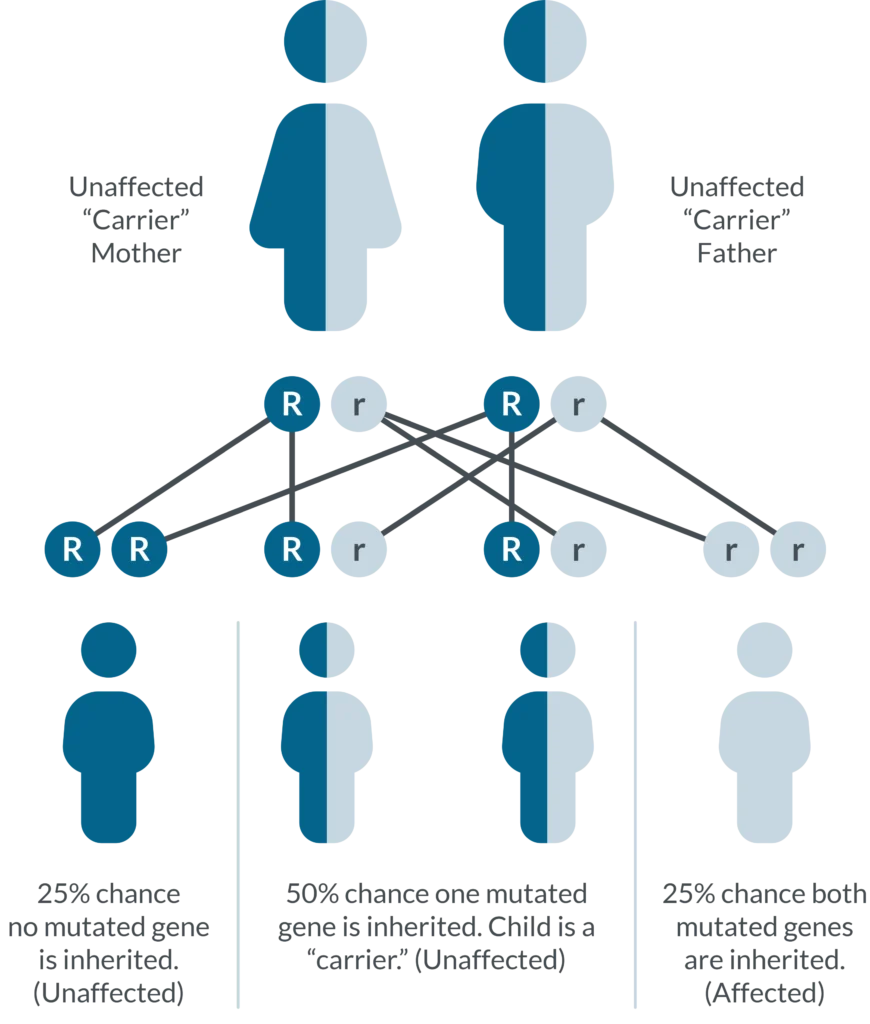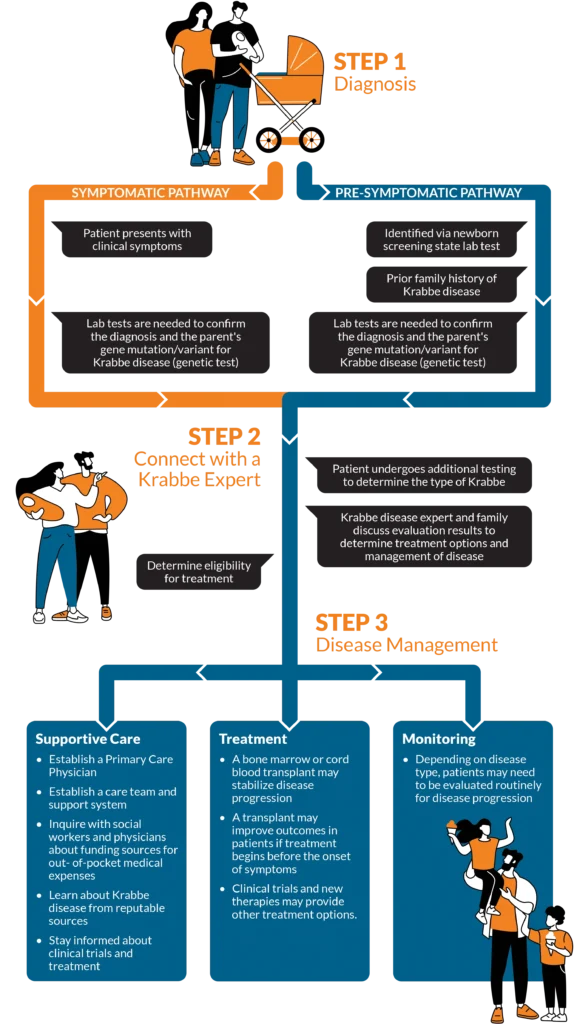Krabbe disease—also known as globoid cell leukodystrophy—is a rare, inheritedThe way genes are passed down from one generation to the next. There are many different types of inheritance patterns. Krabbe disease is inherited in an autosomal recessive pattern of inheritance. genetic disorder. It’s part of a group of disorders called leukodystrophies, which result from the loss of myelinMyelin is an essential material your body uses to surround and protect nerve fibers. in the nervous systemThe nervous system of the body is made up of the Central Nervous System (CNS) and the Peripheral Nervous System (PNS).. Krabbe disease is also classified as a lysosomal storage disorder (LSD).
Early Infantile Krabbe Disease (EIKD) is the most common form of Krabbe disease. Because the disease is progressive, babies with EIKD may appear normal for the first few months of life and then begin to develop noticeable symptoms. The onset of symptoms of the Early Infantile form appear clinically between 0 to 12 months of age.
Symptoms of Early Infantile Krabbe Disease
Krabbe disease is a progressive degenerative condition. Babies may appear normal for the first few months before symptoms develop. Early Infantile Krabbe Disease symptoms start out mild, but will get worse over time. EIKD symptoms include:
- Extreme irritability (above and beyond colic);
- Sensitivity to sound (easily startles);
- Vomiting (appears to not keep a majority of feedings down);
- Feeding difficulty (significant decrease in daily consumption of formula/breast milk);
- Loss of milestones (no longer tracks objects or giggles); and
- Muscle weakness.

Diagnosing EIKD
Initial diagnosis in infants is generally done through a blood screening. In some states, this test is performed as part of the newborn screening panel. Click here to check if your state currently screens for Krabbe disease. If this blood test detects a low level of galactocerebrosidase (or GALC for short) and a high level of psychosineDue to the enzyme deficiency in Krabbe disease, psychosine accumulates in the nervous system of affected individuals. Psychosine, a galactolipid, is a cytotoxic type of lipid, that has destructive pr, the infant may be positive for Krabbe disease. Genetic testing is then done to confirm the presence of two copies of the disease-causing GALC gene.
Genetic counseling and prenatal tests can also determine if someone carries the gene for Krabbe disease or if a developing baby has the condition. Other diagnostic tests—such as MRIs—can also be used but they are not common for diagnosing babies with EIKD.
Causes of Krabbe Disease
Krabbe disease is caused by a deficiency of the enzymeA protein needed by the body to break down certain substances by causing a biochemical reaction within the cells. In Krabbe disease, galactocerebrosidase is the deficient enzyme. Words that end in galactocerebrosidaseA specific enzyme that receives its instructions from the GALC gene. When the GALC gene isn’t working properly, the enzyme, galactocerebrosidase, is unable to break down certain fats called galactol More (GALC), which breaks down fats in the body. When lipidsIn Krabbe disease a lipid describes a type of fatty storage material that accumulates in cells. aren’t broken down, the myelin sheath that protects nerve cells deteriorates (demyelinationA process whereby the body breaks down the protective coating surrounding nerves.). The demyelination results in the destruction of brain cells, which causes progressive neurological issues that get worse over time.
Krabbe disease occurs because of mutationsThis is an older word used to describe a change in a specific gene leading to disease. As not all mutations are bad, the word mutation has been replaced with the term “pathogenic variant” that d in the GALC gene, located on chromosome 14. Every person has two GALC genesThe GALC gene is located on chromosome 14. This gene provides instructions for making the enzyme galactocerebrosidase. This enzyme breaks down certain fats called galactolipids. Galactocerebrosidase More, one inherited from each parent. Most people carry two normal sets of GALC genesThe body is made of ~20,500 genes, each of which has a specific function within the body. Our genes are what makes each one of us unique- from our green eyes to our curly hair., but some people carry a mutated GALC gene. These people are carriers, but do not usually have any symptoms associated with Krabbe disease.
Krabbe disease follows an autosomal recessive pattern, which means that a person must inherit two defective GALC genes—one from each parent—to develop the disease.
If only one parent is a carrier (has the defective GALC gene), there is a 50% chance the defective gene may be passed to the child but they also would only be a carrier and would likely show no symptoms.
If both parents are carriers, however, there is a 25% percent chance a child would not inherit either defective gene, a 50% chance they would inherit one defective gene (be a carrier), and a 25% chance that they would inherit both defective genes and develop Krabbe disease.
Because of this autosomal recessive pattern, it’s possible for a set of parents to have some children with EIKD, and some without.
Autosomal Recessive Pattern

Treatment of Krabbe Disease
Unfortunately, there is no cure for Early Infantile Krabbe Disease. Treatment options for EIKD will vary depending on how quickly it is diagnosed. If the child is diagnosed before EIKD symptoms appear, additional treatment options may be available.
By the time a child is experiencing symptoms, they may have already sustained irreversible brain damage which disqualifies them as a candidate for more advanced interventions. That is why KrabbeConnect’s ongoing efforts to get Krabbe disease on more newborn screening panels is so vital.
Once symptoms have occurred, treatments generally focus on palliative or supportive care to help manage symptoms and improve the quality of life of the child, including:
- Muscle relaxants to help control spasms
- Anticonvulsants to help seizures
- Physical therapy to increase mobility
- Tube feedings
Putting together an experienced medical care team is crucial. Connect with a Clinical Expert in Krabbe Disease.

Patient Support and Resources for Early Infantile Krabbe Disease
If your infant has been diagnosed with Early Infantile Krabbe Disease (EIKD), patient support and resources are available from KrabbeConnect. Our Peer to Peer support team is here to help answer your questions and provide guidance from their own experiences. You can also call our hotline 24/7 at 1 (800) 800-5509 for resources, support, and access to Krabbe disease experts. Our Patient Assistance Program provides grants and access to donated equipment to help in caring for your child.
The information on this site is for educational purposes only and is not intended or implied as a substitute for professional healthcare advice, diagnosis, or treatment. All content, including text, graphics, images, and information, contained on or available through this website is for general information purposes only.


